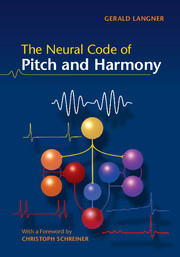Book contents
- Frontmatter
- Contents
- Preface
- Foreword
- 1 Historical aspects of harmony
- 2 Sound and periodicity
- 3 The discovery of the missing fundamental
- 4 The pitch puzzle
- 5 The auditory time constant
- 6 Pathways of hearing
- 7 Periodicity coding in the brainstem
- 8 Periodicity coding in the midbrain
- 9 Theories of periodicity coding
- 10 Periodotopy
- 11 The neural code of harmony
- 12 The oscillating brain
- References
- Index
Preface
Published online by Cambridge University Press: 05 May 2015
- Frontmatter
- Contents
- Preface
- Foreword
- 1 Historical aspects of harmony
- 2 Sound and periodicity
- 3 The discovery of the missing fundamental
- 4 The pitch puzzle
- 5 The auditory time constant
- 6 Pathways of hearing
- 7 Periodicity coding in the brainstem
- 8 Periodicity coding in the midbrain
- 9 Theories of periodicity coding
- 10 Periodotopy
- 11 The neural code of harmony
- 12 The oscillating brain
- References
- Index
Summary
Sound is a vital tool for humans and animals. We communicate with each other through speech, we convey emotion by laughing or crying, but we also purposefully create sounds using our voices or musical instruments just because we perceive them to be appealing or beautiful. The pitch, rhythm and melody of speech and music can communicate emotions like fear, pleasure and anger quite quickly and efficiently. Moreover, as humans we seem to have a powerful urge to fill the world with sounds of our own creation, with the result that these days music surrounds us virtually everywhere. The need to make, listen and dance to music stretches back to the very beginnings of our history: for many thousands of years music has played an essential role in our social interactions, rituals and ceremonies. The sixth-century Roman philosopher and great musical theorist Boethius stated quite simply:
it appears beyond doubt that music is so naturally united with us that we cannot be free from it even if desired.
We all know that some combinations of musical tones sound particularly good when played together or subsequently; we call these ‘consonant’ or ‘harmonious’, while others sound harsh or ‘dissonant’. If asked what combinations of sounds they find pleasant, or at least interesting, people from different cultural back- grounds may not completely agree. Different forms of music prevail in different regions of the world, and musical instruments and composition have become progressively more sophisticated as civilization advances. Nevertheless, there are certain combinations of tones that seem to have universal appeal. They are preferred everywhere and form the basis of musical systems throughout the world. Clearly, there must be some universal rules that are crucial to our perception of musical harmony.
The question of what these rules are and what might be the role of whole numbers dates back to the time of the ancient Greeks.
- Type
- Chapter
- Information
- The Neural Code of Pitch and Harmony , pp. xi - xiiPublisher: Cambridge University PressPrint publication year: 2015



